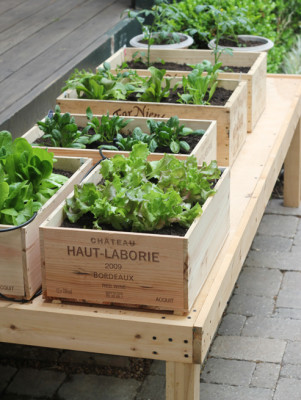Container and Aquaponics Gardening
Container Gardening
Container gardening can be an effective way to grow plants in a cramped space. Even if you can’t actually tear up your ground and plant a garden you can enjoy the benefits of growing your own produce. There are special varieties of plants that thrive in containers- cherry tomatoes, strawberries, lettuce, and many types of herbs; like basil, oregano and mint, and you can even grow beets and carrots in a container. It is easy to find suitable containers for free or at garage sales- you can grow a plant in mostly anything provided it did not once contain toxic chemicals.
Create containers suitable for growing out of almost anything- you need a drainage hole on the bottom (you can drill one too), gravel or stone layered in the bottom, then fill the container with fertilizer or compost enriched soil. Remember that container plants need to be watered more often than plants in a garden bed- especially during hot, dry weather. A good application of compost or fertilizer twice a season helps plants flourish. Compost tea can be applied via a watering can directly to the container’s soil too. The beauty of growing in containers is that it allows some plants to be grown over winter indoors if space permits.
AquaponicsThis type of garden bed requires a good amount of space and specialized equipment; however the upkeep can be less than a traditional garden bed and a surprising amount of food can be produced on very little. Unlike traditional hydroponics, aquaponics mimics the symbiotic relationship of fish and plants. Basically the fish provide the nutrients for plants that grow in a soil-less medium designed to hold water and anchor roots. The grow beds are flooded with the fishes waste water- which is a great source of nutrients for the plants. After the plants suck up the nutrients the water is clean and recycled back into the fish’s tank.
There are many specific details that this set up entails- precise calculations: every system has to be in balance with one another. The payoff is beautiful though, fresh fish and water loving plants grow in abundance. There can be lettuce, scallions, strawberries, and tomatoes all fertilized by the fish’s excrement: aquaponics is a truly closed system when done correctly. But the startup costs can be expensive and the technical aspects of this system do not make it ideal for a beginning gardener. However, there are ways to start small, you can even do this on a tiny scale using a home aquarium and growing a small herb garden indoors. If you have an unused greenhouse or similar structure an aquaponics system may prove to be a good match for the space. Trout grow well in colder climates while in warmer climates Tilapia grows best. You can even grow your fish food hydroponically.






